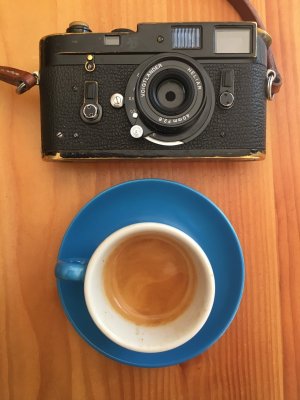farlymac
PF McFarland
It's a fine but blurred line between most-bang-for-the-buck and personally preferred. When I got my M4-P it was not only after researching all the other models for what features they had and what they cost, but because it had a very slight ding on the early top brass cover it was discounted at least a couple hundred dollars under any other one I could find. Every time I use it I just consider myself lucky to have found it when I did. The six viewfinder frame lines, the easy-load film system, the rewind crank, hot accessory shoe, and the black chrome looks were all the things that impressed me. And when I mount the Rapidwinder it is a joy to use. And now it's worth more than double what I paid for it. There's your bang-for-the-buck!
PF
PF
Ronald M
Mentor
One in good condition that works. Every used one I have purchased ended up need expensive work.
Deardorff38
Mentor
Ouch.... those are pretty bad odds. My experience is owning somewhere around 15 over the decades from new black paint M4, & CLs, M4-2s and M4-P to M6 titaniums to 1934 iii and used M2s, M4s,MP and CL and only one required service.One in good condition that works. Every used one I have purchased ended up need expensive work.
steveyork
Well-known
One in good condition that works. Every used one I have purchased ended up need expensive work.
Most old cameras need some type of service, even if only a basic CLA. I've had a dozen or so old Leica M's come through the house over the years and each one benefited from a CLA. None needed "expensive work." But the same is true for old Nikons. I've had 5-6 old S2's and 2 original S3, and the same number of F's, and they all needed something repaired, from meters to shutter calibrated -- only a pair of F3's from the 80's needed nothing. So yeah, sounds like you've had some bad luck if your repairs were beyond a basic CLA. A CLA should be assumed for an old camera; any old camera.
Deardorff38
Mentor
I agree, that is true now that we're talking about cameras that are 30-50+ yrs old. But 'back-in-the-day' when we were buying used cameras (to use...not to collect), a 2-10 yr old Leica or Nikon that had been used but not abused, often needed nothing.....& the 'needs a CLA' every couple of years kept service departments busy, but was not really a necessity.Most old cameras need some type of service, even if only a basic CLA. I've had a dozen or so old Leica M's come through the house over the years and each one benefited from a CLA. None needed "expensive work." But the same is true for old Nikons. I've had 5-6 old S2's and 2 original S3, and the same number of F's, and they all needed something repaired, from meters to shutter calibrated -- only a pair of F3's from the 80's needed nothing. So yeah, sounds like you've had some bad luck if your repairs were beyond a basic CLA. A CLA should be assumed for an old camera; any old camera.
CSG1
Newbie
My M4 came to me when it was 44 years old. It had had a CLA in the past and worked fine all these years right up until the shutter curtain separated. It is now 57 years old and will be sent in for that repair and a CLA and, possibly, lug replacement. I expect to spend $500-700. I paid $600 net in 2010. It was the best M for the money then (IMO) and at $1500-2000 for a clean one today (with a recent CLA) is a bargain in my world. The M4 was the last of the old school hand-fitted Leicas.
Gordon Moat
Established
Going to be a bit unpopular, but if you want to use M-mount lenses, and want lots of value for the money, it’s tough to beat the Zeiss ZM and Konica Hexar RF. Of course, that’s not what this thread is about, and it’s really the lure of a Leica M body, with those ergonomics and rangefinder. The lenses you want to use will influence that decision, especially the focal length you want to use the most. The other factor is whether you want a built-in meter, in which case you would want to look at the M6 and M6 TTL.
My personal choice is the M4-2, which many don’t like because it’s Canadian. I’m originally from Germany, so I’m fine using something not made in Germany. (Shock/horror - I also have some lenses made in Japan). Anyway, I’m not saying “buy an M4-2”, but rather don’t be dismissive of any M bodies (well, except maybe the M5, because that’s just weird). So for me the M4-2 matched the lenses I want to use, and gives a low clutter viewfinder experience. I’m also fine without a built-in meter, especially that I don’t have to ever think about a meter failure in my lifetime.
However, it’s really tough to beat an M6. Leica just started remaking them, though there’s a ton of used bodies on the market. You unlock all the M-mount frame lines in the viewfinder. There’s a wide range of finishes, a few collectible versions, and some low usage clean used cameras available for purchase.
My personal choice is the M4-2, which many don’t like because it’s Canadian. I’m originally from Germany, so I’m fine using something not made in Germany. (Shock/horror - I also have some lenses made in Japan). Anyway, I’m not saying “buy an M4-2”, but rather don’t be dismissive of any M bodies (well, except maybe the M5, because that’s just weird). So for me the M4-2 matched the lenses I want to use, and gives a low clutter viewfinder experience. I’m also fine without a built-in meter, especially that I don’t have to ever think about a meter failure in my lifetime.
However, it’s really tough to beat an M6. Leica just started remaking them, though there’s a ton of used bodies on the market. You unlock all the M-mount frame lines in the viewfinder. There’s a wide range of finishes, a few collectible versions, and some low usage clean used cameras available for purchase.
Deardorff38
Mentor
"You unlock all the M-mount frame lines in the viewfinder." For many Leica RF users this is a hindrance rather than an advantage....
Gordon Moat
Established
I somewhat agree, which is why I went for an M4-2 over the M4-P (or M6). I like the cleaner viewfinder."You unlock all the M-mount frame lines in the viewfinder." For many Leica RF users this is a hindrance rather than an advantage....
Deardorff38
Mentor
Slumgullion
Established
Yes, but have you ever seen the M5 finder? 
Just the critical framelines, with marks for the meter area (which is literally the smartest, most useful element of any metered finder...only matched by my Nikon F6 in spot meter mode), match needle metering (which is superior to the M6 classic with two LEDs, IMO...it's more informative and thus accurate) and...shutter speed read out...in the finder. It's very clean, uncluttered and bright.
Additionally, you have a brass top plate and it's the last of the 'adjust and fit' production Leicas.
I get it that M3s, M2s, and M4s are beautiful cameras...but spending $1500+ for a meterless 35mm camera didn't make sense to me when I went shopping for my first Leica last year. Everyone's values and wallet are different, so your mileage may vary.
Just the critical framelines, with marks for the meter area (which is literally the smartest, most useful element of any metered finder...only matched by my Nikon F6 in spot meter mode), match needle metering (which is superior to the M6 classic with two LEDs, IMO...it's more informative and thus accurate) and...shutter speed read out...in the finder. It's very clean, uncluttered and bright.
Additionally, you have a brass top plate and it's the last of the 'adjust and fit' production Leicas.
I get it that M3s, M2s, and M4s are beautiful cameras...but spending $1500+ for a meterless 35mm camera didn't make sense to me when I went shopping for my first Leica last year. Everyone's values and wallet are different, so your mileage may vary.
Deardorff38
Mentor
All the things you say are true SG. I would have preferred a match needle M6 with M2 windows. But.....as you say, the M5 was your first Leica. The handling and feel of the M5 was so different than the other M models. Like every tool, how it handles for the user is at least as important as its specifications (true of cars, guitars, hand tools etc). I had been using M cameras for 5 years when I bought a new M5. I didn't have it very long. Despite it's ++..... it was just downright awkward for me. Obviously for others it's a delight...& today it is a bargain for a fine camera.Yes, but have you ever seen the M5 finder?
but spending $1500+ for a meterless 35mm camera didn't make sense to me when I went shopping for my first Leica last year. Everyone's values and wallet are different, so your mileage may vary.
I suppose also why so many people love the Barnack Leicas. The 35mm roll of film is so small.....how big can you make a camera? and how many features can you add? ...before it loses its appeal. I always prefer printing from big negatives. My 6x6 Perkeo ll is barely bigger than an iphone...& smaller than an M5
Last edited:
The M5 is definitely different in handling, and all in a good way. 
Adjusting the shutter speed on other Ms is an awkward affair; with the M5, a little flick of the index finger is all it takes, far easier. Having the speeds in the viewfinder means not having to count stops, or worse, take the camera away from the eye to see what speed is set, and risk losing the decisive moment.
The viewfinder and metering advantages are already well-described above. The rest of the camera is the same as other Ms in every way -- the loading is the same as M4 and up, and so on. And as for size and weight, a Leicameter on an M4 weighs within a few grams of an M5, while occupying the shoe, which is better utilized for 21mm viewfinders and such.
At today's prices it's hard to beat a well-sorted M5 over any later metered M, going for roughly half the cost of an identical condition M6.
Adjusting the shutter speed on other Ms is an awkward affair; with the M5, a little flick of the index finger is all it takes, far easier. Having the speeds in the viewfinder means not having to count stops, or worse, take the camera away from the eye to see what speed is set, and risk losing the decisive moment.
The viewfinder and metering advantages are already well-described above. The rest of the camera is the same as other Ms in every way -- the loading is the same as M4 and up, and so on. And as for size and weight, a Leicameter on an M4 weighs within a few grams of an M5, while occupying the shoe, which is better utilized for 21mm viewfinders and such.
At today's prices it's hard to beat a well-sorted M5 over any later metered M, going for roughly half the cost of an identical condition M6.
steveyork
Well-known
In my experience, always felt the M5 was the best metered Leica rangefinder, followed by the M7. At least the M5 has more accurate frame lines. Though now I like meterless cameras. Have the exposure settings for most lighting situations memorized from use. Don't need a meter to tell me what I already know. Makes the brain work a little too when I have to Sunny 16 a scene. They're all good really.
Last edited:
Deardorff38
Mentor
That's the thing about personal choices Split.... they're the choice of the individual. 18.7% of folks who answered the survey agree with you the the M5 is a great deal. Enough of us disagreed with the design between 1971-75 that Leica stopped production. The M5 apparently almost sank the Leica ship..... Some people loved the Ford Edsel as wellThe M5 is definitely different in handling, and all in a good way.
Adjusting the shutter speed on other Ms is an awkward affair; with the M5, a little flick of the index finger is all it takes, far easier. Having the speeds in the viewfinder means not having to count stops, or worse, take the camera away from the eye to see what speed is set, and risk losing the decisive moment.
The viewfinder and metering advantages are already well-described above. The rest of the camera is the same as other Ms in every way -- the loading is the same as M4 and up, and so on. And as for size and weight, a Leicameter on an M4 weighs within a few grams of an M5, while occupying the shoe, which is better utilized for 21mm viewfinders and such.
At today's prices it's hard to beat a well-sorted M5 over any later metered M, going for roughly half the cost of an identical condition M6.
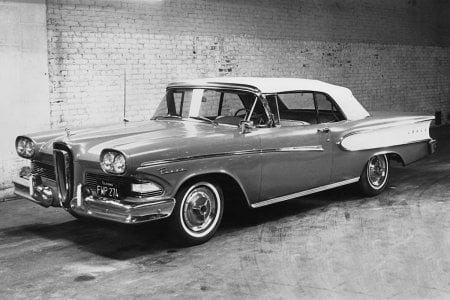
There were many more issues facing Wetzlar during that era than just the M5.  Unfortunate timing for one, as the market was going full-tilt SLR with Japanese domination. And Leica was losing money on every Leicaflex...and perhaps on the M5 too.
Unfortunate timing for one, as the market was going full-tilt SLR with Japanese domination. And Leica was losing money on every Leicaflex...and perhaps on the M5 too.
The CL production was about double, yet it only got 2 votes in this poll.
None of this matters now, of course. The handling superiority is obvious, and the price is a big advantage, comparing equivalent condition models.
The CL production was about double, yet it only got 2 votes in this poll.
None of this matters now, of course. The handling superiority is obvious, and the price is a big advantage, comparing equivalent condition models.
Deardorff38
Mentor
I agree with you especially about the CL. I used several of them quite heavily in the mid-late 70s always without a hitch. DAG agrees that they are much more robust camera than people assume. I am again using one..... like the proverbial Duracell bunny...they just keep on ticking.There were many more issues facing Wetzlar during that era than just the M5.Unfortunate timing for one, as the market was going full-tilt SLR with Japanese domination. And Leica was losing money on every Leicaflex...and perhaps on the M5 too.
The CL production was about double, yet it only got 2 votes in this poll.
None of this matters now, of course. The handling superiority is obvious, and the price is a big advantage, comparing equivalent condition models.
I had two CLs for several years that were non-working. Sent them off to Gus Lazzari and they came back looking like they had just come out of the factory. Amazingly clear viewfinders! I foolishly sold them both. 
Deardorff38
Mentor
A couple of months ago, my CL was damaged... I'm not sure how... back of taxi? plane overhead bin? I took it to Gary Clennan in Calgary and he was able to find an NOS range/viewfinder glass and make the top dent go away.... Good as new. For all the places i've dragged these things it's ironic to have one damaged while simply travelling....I had two CLs for several years that were non-working. Sent them off to Gus Lazzari and they came back looking like they had just come out of the factory. Amazingly clear viewfinders! I foolishly sold them both.
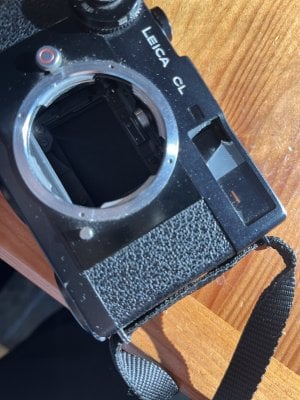
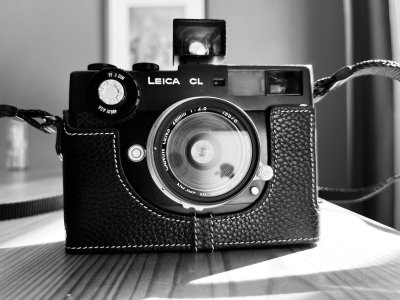
Pál_K
Cameras. I has it.
The M5 is the one M I should’ve bought instead of an extra M3 and extra M6.
Two things I may never know about Leica is why they chose the meter on a stick for the M5 instead of the white patch on the curtain as they did for the M6. Maybe the technology wasn’t good enough. The other puzzle is why they chose 50-90-135 for the M3. Perhaps their intent was that if you like the longer focal lengths, get the M3, otherwise get the M2.
As for Edsels, in 1960 they looked good. My understanding is that the car failed due to its price point and features relative to the Mercury and Lincoln.

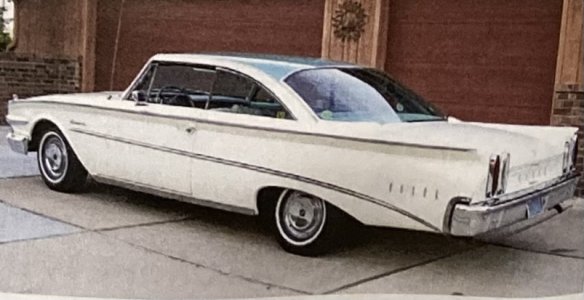
Two things I may never know about Leica is why they chose the meter on a stick for the M5 instead of the white patch on the curtain as they did for the M6. Maybe the technology wasn’t good enough. The other puzzle is why they chose 50-90-135 for the M3. Perhaps their intent was that if you like the longer focal lengths, get the M3, otherwise get the M2.
As for Edsels, in 1960 they looked good. My understanding is that the car failed due to its price point and features relative to the Mercury and Lincoln.


Share:
-
This site uses cookies to help personalise content, tailor your experience and to keep you logged in if you register.
By continuing to use this site, you are consenting to our use of cookies.


